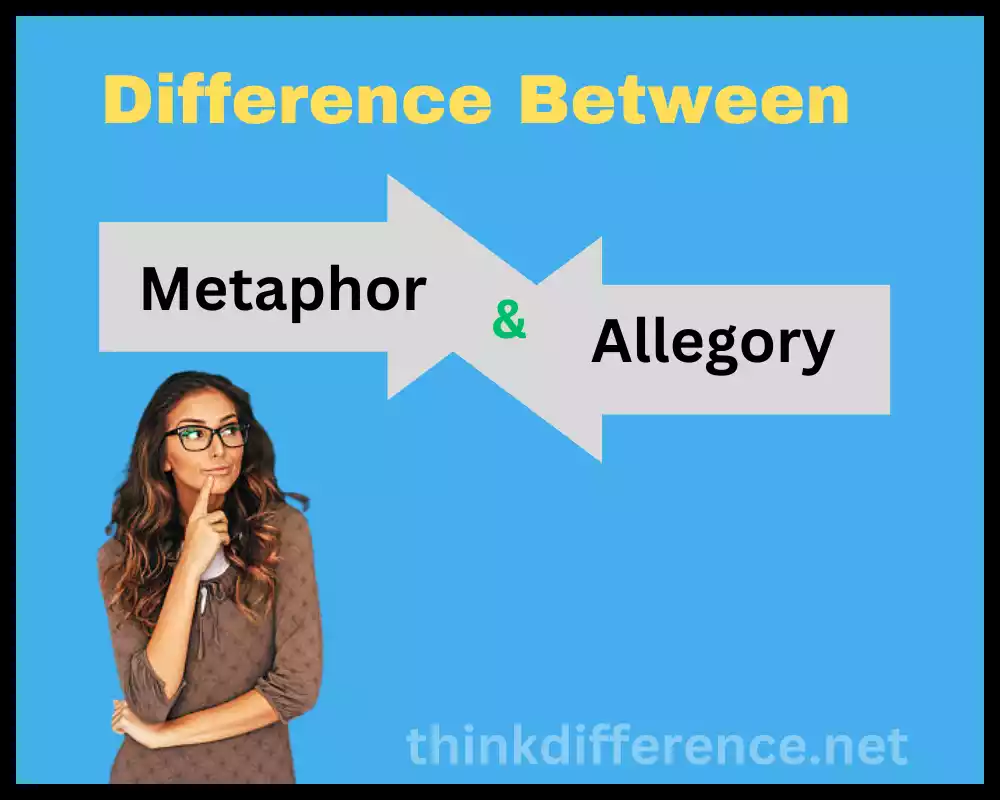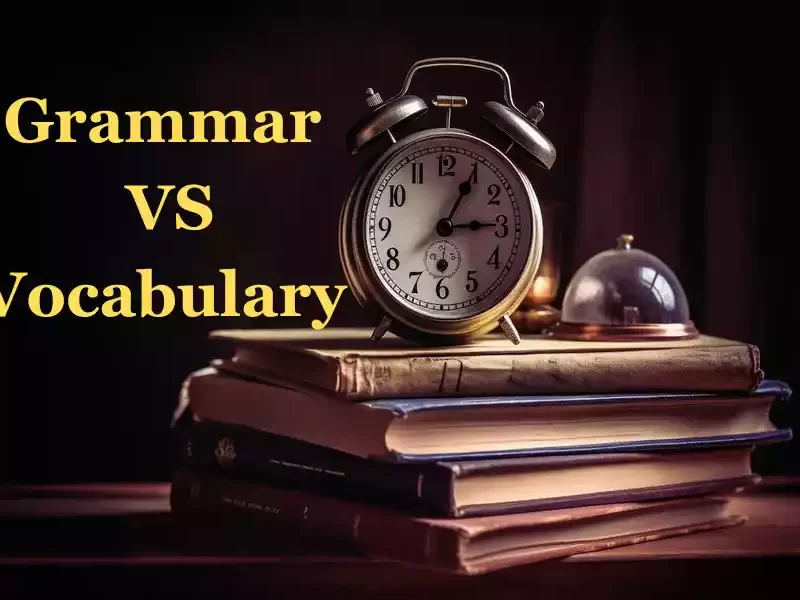Explanation of Metaphor and Allegory
Metaphor:
A metaphor is a figure of speech that compares two unrelated things by stating that one thing is another thing, without using “like” or “as.” It highlights the similarities or shared characteristics between the two subjects, often providing a fresh perspective or insight. Metaphors are commonly used in literature, poetry and everyday language to enhance descriptions, create vivid imagery and convey abstract or complex ideas in a concise and memorable way.
By invoking sensory and emotional connections, metaphors engage the reader and stimulate their imagination. For example, the phrase “Time is money” equates time with the value and importance placed on money, emphasizing the preciousness and finite nature of time.
Allegory:
An allegory is a narrative or artwork that uses symbolic characters, events or elements to represent abstract ideas, moral lessons or complex concepts. Unlike a metaphor, which is a single comparison, an allegory is an extended metaphor that unfolds throughout an entire work. In an allegory, characters and events have symbolic meanings beyond their literal interpretations, often functioning as representations of broader concepts or societal issues.
Allegories can be found in literature, fables, myths and visual arts. They provide multiple layers of interpretation, allowing readers or viewers to delve deeper into the hidden messages and explore different levels of symbolism. Allegories are often used to critique society, politics or human nature and to convey complex ideas or moral lessons through storytelling.
George Orwell’s Animal Farm provides one such allegory; wherein its animals represent various political ideologies as well as Russia’s Revolution. Plato’s Allegory of the Cave presents another such allegory depicting man’s journey from ignorance towards enlightenment.
While both metaphor and allegory employ figurative language and can communicate abstract ideas, they differ in terms of scope, complexity, use of symbols, narrative structure and levels of interpretation. Metaphor is typically a single comparison used within a broader context, whereas allegory encompasses an entire narrative structure. Metaphor relies on isolated comparisons, while allegory utilizes a network of interconnected symbols.
Metaphors can be used in any form of writing or speech, whereas allegories require a narrative structure to convey their intended meaning. Metaphors generally have one intended meaning or interpretation, while allegories allow for multiple layers of interpretation and varying levels of symbolism. The intention and purpose of the author in using metaphor are often for rhetorical or artistic effect, while allegories are frequently employed to convey specific messages or critiques.
Importance of Metaphor and Allegory
Metaphor and allegory play significant roles in literature, art and communication, serving various important purposes:
- Enhancing Understanding: Metaphor and allegory provide powerful tools for conveying complex or abstract ideas in a more relatable and accessible manner. By using vivid imagery and imaginative comparisons, they can clarify and illuminate concepts that might otherwise be difficult to grasp.
- Stimulating Imagination: Metaphor and allegory engage the reader or viewer’s imagination, encouraging them to create mental images and make connections between seemingly unrelated concepts. They invite active participation and interpretation, fostering deeper engagement and a more personal connection to the subject matter.
- Evoking Emotion: Metaphor and allegory have the ability to evoke emotions and create a deeper emotional impact. By drawing upon familiar or evocative imagery, they can tap into the reader’s or viewer’s emotions, making the message more memorable and resonant.
- Promoting Critical Thinking: Metaphor and allegory often require readers or viewers to think beyond literal interpretations and delve into symbolic meanings. They challenge individuals to analyze and interpret the underlying messages, stimulating critical thinking skills and encouraging a deeper exploration of the subject matter.
- Encouraging Multiple Perspectives: Metaphor and allegory allow for multiple layers of meaning and interpretation. They can be understood and appreciated differently by different individuals, fostering diverse perspectives and opening up discussions and debates about the intended messages and symbolism.
- Engaging Creativity: Metaphor and allegory are creative devices that offer opportunities for writers, artists and communicators to express ideas in unique and imaginative ways. They provide space for artistic exploration, enabling the creation of rich and layered works that captivate and inspire audiences.
- Social and Political Commentary: Metaphors and allegories have long been employed as powerful forms of social and political commentary. They can offer a means to critique or reflect upon societal issues, ideologies or power dynamics in a way that may be more indirect or less confrontational, allowing for nuanced exploration of complex topics.
Metaphor and allegory are essential tools in literature, art and communication, enabling deeper understanding, emotional connection, critical thinking and creative expression. They provide a means to convey complex ideas, stimulate the imagination and foster meaningful engagement with the subject matter.
Metaphor
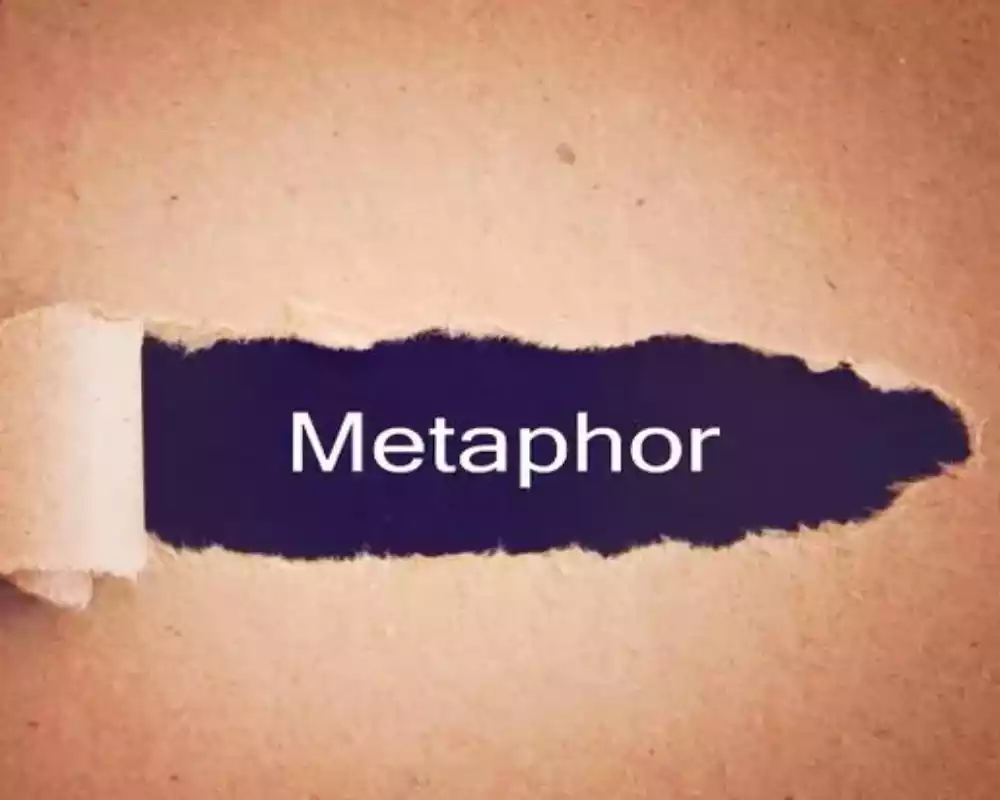
Metaphor is an expression which compares two unrelated ideas or objects by asserting they share similarities without using “like” and “as.” A metaphor serves to better illustrate an object by drawing parallels to another thing – often leading to deeper insight or providing fresh perspectives.
Metaphors can be utilized across many areas of communication including poetry, literature, speeches and everyday language. When deployed appropriately metaphors help improve descriptions, invoke emotions or concisely and easily convey abstract or complex concepts with minimal cognitive load for readers.
By employing metaphors we can evoke vivid pictures in the minds and hearts of our audiences. Metaphors help express abstract concepts, feelings, or qualities by associating these with everyday or tangible items.
Example: “He is a shining star” is an idiomatic way of referring to someone with exceptional talent or achievement; its literal translation conveys this meaning with imagery of bright stars illuminating a dark sky. By contrast, “Time is the Thief” implies that time steals precious moments away.
Metaphors play an integral part in literature by adding depth and richness, engaging the imagination of readers while stimulating sensory experience, engaging their participation actively throughout reading.
Metaphors can be extremely effective communicators. They enable us to express ourselves more creatively, expressively and emotionally than other means can. Metaphors also serve to clarify complex ideas; stimulating reader emotions while drawing them closer into an experience related to it.
Allegory
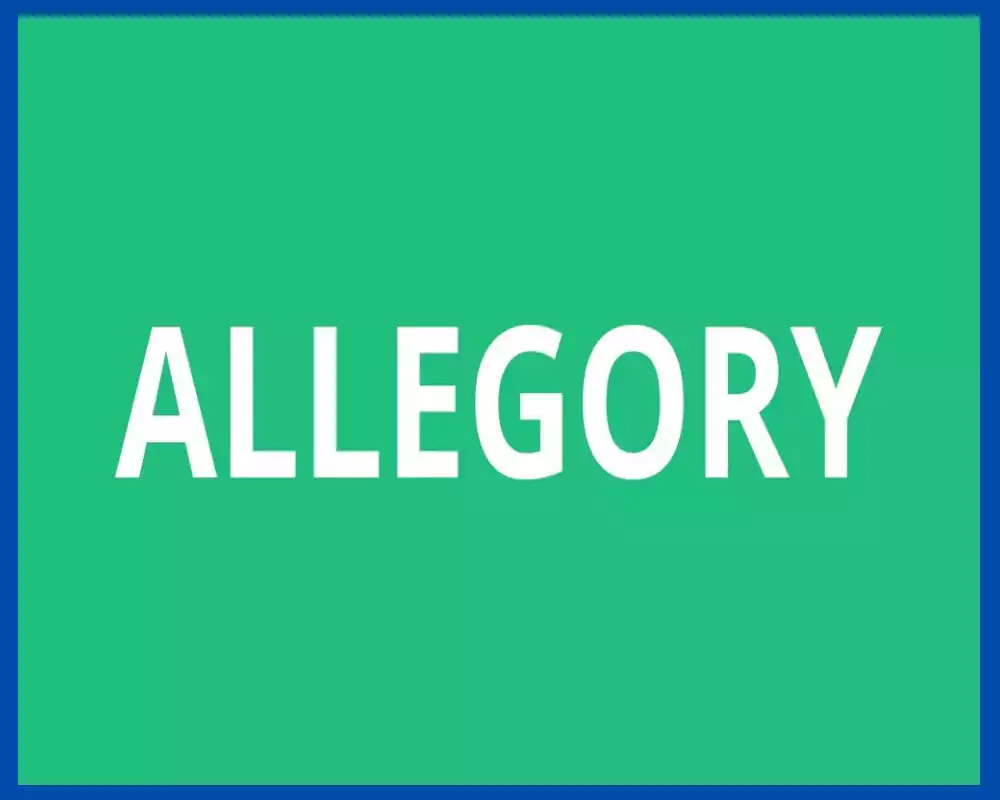
Allegories are artwork or stories which use symbols to symbolize abstract concepts, moral principles or complex ideas. By employing symbolic language in their creation and use in storytelling, allegories convey deeper messages or meaning.
Allegories are stories in which characters, objects or events serve as representations for larger concepts or themes. Many allegories offer multiple interpretations to readers or viewers and encourage critical thought.
Allegories can be found throughout literature, film and art – from literature and painting to films and sculpture. Artists use allegories as an accessible way of exploring complex topics while conveying difficult messages to audiences. Allegories also serve to make abstract ideas or morals tangible by using symbols and symbolic associations that connect directly to concrete ideas or morals.
Allegories’ rich symbolic layers allow for various interpretations and encourage viewers or readers to interact on various levels with them, encouraging viewers or readers to discover different meanings or insights gleaned from an allegory resulting in discussions on various levels about what the story means for them individually and as an overall whole. This allows a wide array of viewpoints to emerge during viewing or reading an allegory story.
Allegories have long served as forms of social and political commentary. Used to examine or criticise issues within society or human nature itself, allegories use symbolic representations to challenge norms while exploring moral dilemmas or providing insights into human nature – an invaluable way to challenge existing norms and bring questions about existing ones.
Allegories have long been employed in works like John Bunyan’s The Pilgrim’s Progress which describes a spiritual journey taken by its protagonist; or George Orwell’s Animal Farm where animals stand for political ideologies or events associated with Russia during its Revolution.
Allegory, the use of symbols and metaphors as storytelling devices to convey moral messages or deeper meanings through fictional stories, encourages critical thought by opening up abstract concepts for exploration; provides social commentary platform. Allegories engage viewers or readers intellectually and emotionally and foster greater appreciation and comprehension of themes or ideas being conveyed.
Differences between Metaphor and Allegory
Metaphor and allegory are both literary devices that involve the use of figurative language but they have distinct differences in terms of scope, structure and purpose.
Here are the key differences between metaphor and allegory:
1. Scope:
- Metaphor: Metaphor is a single comparison between two unrelated things or ideas, highlighting their similarities or shared characteristics. It is often a brief expression within a larger context.
- Allegory: Allegory is an extended narrative or artwork that unfolds throughout an entire work. It involves multiple characters, events, or elements that symbolically represent abstract ideas, moral lessons or complex concepts.
2. Use of Symbols:
- Metaphor: Metaphor is an indirect comparison that does not rely heavily on symbols to convey meaning. It is a more straightforward comparison of two concepts or objects.
- Allegory: Allegory heavily relies on the use of symbols. Characters, objects or events in an allegory carry deeper symbolic meanings beyond their literal interpretations. The entire narrative functions as a network of interconnected symbols.
3. Narrative Structure:
- Metaphor: Metaphors can be applied in all kinds of writing without needing an overarching narrative structure. It can be a single line or sentence.
- Allegory: Allegory requires a narrative structure to convey its intended meaning. It typically involves a story with characters, a plot, and a progression of events that serve as a vehicle for the symbolic representation and exploration of ideas.
4. Levels of Interpretation:
- Metaphor: Metaphors generally have one intended meaning or interpretation, although they can evoke various personal associations or interpretations for different individuals.
- Allegory: Allegory allows for multiple layers of interpretation and varying levels of symbolism. It encourages readers or viewers to explore and interpret the hidden messages and symbolism within the work. It can be subject to different interpretations and may have complex and nuanced meanings.
5. Intention and Purpose:
- Metaphor: Metaphor is primarily used for rhetorical or artistic effect. It aims to enhance descriptions, evoke emotions and provide fresh perspectives or insights within a specific context.
- Allegory: Allegory often has a specific intention or purpose. It is frequently employed to convey specific messages, moral lessons or social or political critiques. Allegories are often crafted to explore complex ideas or make abstract concepts more tangible and relatable.
Metaphor is a single comparison between two unrelated things, whereas allegory is an extended narrative or artwork that uses symbolic representations to convey deeper meanings. Metaphor is more focused and compact, while allegory requires a broader narrative structure. Metaphor relies less on symbols, while allegory heavily uses symbols to convey its intended message. Metaphors generally have one interpretation, while allegories invite multiple levels of interpretation.
Similarities of Metaphor and Allegory
While metaphor and allegory have distinct differences, they also share some similarities in their use of figurative language and their ability to enhance communication and storytelling.
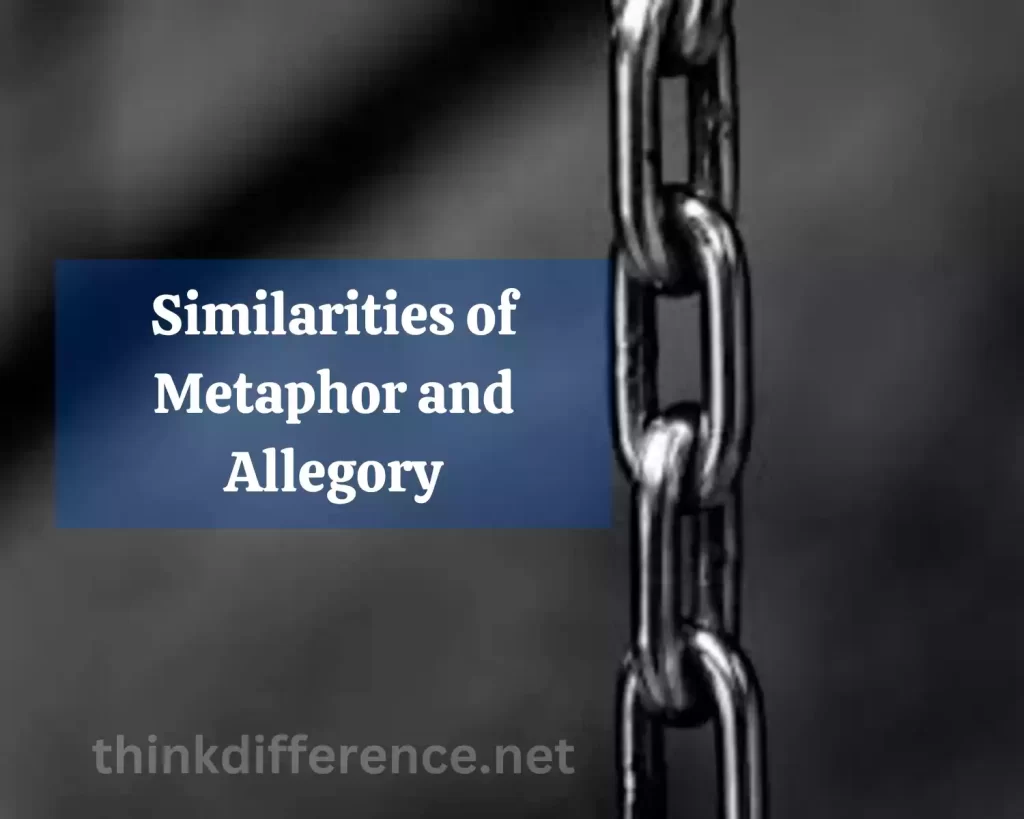
Here are a few similarities between allegory and metaphor:
- Figurative Language: Metaphor and allegory both employ symbolic language in order to convey messages beyond literal interpretations. They go beyond straightforward descriptions and engage the reader’s imagination by creating associations and connections between unrelated concepts or objects.
- Symbolism: Both metaphor and allegory employ symbolism to convey deeper meanings or messages. Metaphors use symbolic comparisons between two things to highlight similarities or shared characteristics. Allegories use symbols throughout the narrative or artwork to represent abstract ideas or concepts.
- Enhanced Communication: Both metaphor and allegory have the power to enhance communication and make complex ideas or abstract concepts more accessible and relatable. They provide vivid and imaginative language that can evoke emotions, create visual imagery and engage the reader or viewer on an intellectual and emotional level.
- Layered Interpretation: Both metaphor and allegory invite interpretation and engage the audience’s critical thinking skills. They can have multiple layers of meaning and offer opportunities for personal reflection and exploration. Both devices encourage readers or viewers to delve deeper into the intended message or symbolism and derive their own insights.
- Creative Expression: Metaphor and allegory provide creative avenues for writers, artists and communicators to express ideas in unique and imaginative ways. They allow for artistic exploration and enable the creation of rich and nuanced works that captivate and inspire audiences.
- Memorable Impact: Both metaphor and allegory have the potential to leave a lasting impact on the audience. Their use of vivid and evocative language along with their ability to tap into emotions and provoke thought, makes them memorable and impactful in the minds of readers.
Metaphor and allegory share the use of figurative language, symbolism and the capacity to enhance communication and storytelling. While their differences lie in scope, structure and purpose, these similarities demonstrate their shared effectiveness in conveying meaning beyond literal expressions.
Use of Metaphor and Allegory in Education
Metaphor and allegory can be valuable tools in the field of education to enhance learning experiences and facilitate understanding. Here are some ways in which metaphor and allegory can be used in education:
- Conceptual Clarity: Metaphors can help clarify abstract or complex concepts by relating them to more concrete and familiar ideas. By using metaphorical language, educators can provide students with relatable comparisons that make difficult concepts more accessible and comprehensible.
- Visualization and Imagination: Metaphors and allegories engage the imagination and help students create mental images and connections between different ideas. They make learning more engaging and memorable by evoking sensory experiences and inviting students to actively participate in the learning process.
- Emotional Connection: Metaphors and allegories can evoke emotions and create a deeper emotional connection to the subject matter. By using vivid and evocative language, educators can tap into students’ emotions and make the learning experience more meaningful and personal.
- Critical Thinking and Analysis: Metaphors and allegories encourage critical thinking skills by challenging students to analyze and interpret the underlying messages and symbolism. They foster deeper levels of interpretation, prompting students to think beyond literal meanings and consider the broader implications and multiple layers of meaning.
- Memory Enhancement: Metaphors and allegories have a greater potential to be remembered compared to dry factual information. The use of vivid imagery and creative associations helps students retain and recall information more effectively. Metaphors and allegories provide hooks that make information more memorable and easier to retrieve.
- Cultural and Historical Understanding: Metaphors and allegories can be used to explore cultural and historical contexts. They can serve as gateways to understanding different perspectives, beliefs and historical events. By using metaphorical references or allegorical narratives from different cultures and time periods, educators can foster cultural competence and historical awareness.
- Ethical and Moral Development: Allegories, in particular, can be employed to discuss ethical dilemmas, moral values and social issues. By using symbolic characters, events or scenarios, educators can stimulate ethical discussions and encourage students to reflect on their own values and beliefs.
The use of metaphor and allegory in education can make learning more engaging, relatable and thought-provoking. They have the potential to enhance conceptual understanding, stimulate critical thinking and create meaningful connections between students and the subject matter.
Examples of Metaphors in Literature
Here are some examples of metaphors in literature:
- “All the world’s a stage, and all the men and women merely players.” – William Shakespeare, As You Like It In this metaphor, Shakespeare compares the world to a stage and people to actors, emphasizing the idea that life is like a theatrical performance.
- “Her eyes were shining stars.” – F. Scott Fitzgerald, The Great Gatsby This metaphor compares the brightness and beauty of a person’s eyes to shining stars, highlighting their captivating and radiant quality.
- “Life is a journey.” – Unknown This metaphor equates life to a journey, emphasizing that life is a process of traveling, experiencing, and encountering various challenges and destinations.
- “Hope is the thing with feathers that perches in the soul.” – Emily Dickinson Dickinson’s metaphor portrays hope as a bird with feathers that finds a place within the soul, suggesting that hope brings comfort and uplifts the spirit.
- “Time is a thief.” – John Donne This metaphor likens time to a thief, suggesting that time gradually steals away precious moments and opportunities.
- “The world is a book, and those who do not travel read only one page.” – Saint Augustine This metaphor compares the world to a book, implying that to truly understand and appreciate the world, one must explore and experience its diverse chapters.
- “The moon was a ghostly galleon tossed upon cloudy seas.” – Alfred Noyes, The Highwayman This metaphor describes the moon as a ghostly ship sailing through a sky filled with clouds, creating a vivid and atmospheric image.
These examples demonstrate how metaphors can enhance descriptions, create vivid imagery and convey complex ideas or emotions in a concise and memorable manner within literature.
Examples of Allegories in Literature
Here are some examples of allegories in literature:
- “Animal Farm,” by George Orwell: This allegoric novel depicts farm animals rebelling against their human farmer to establish an egalitarian society reminiscent of Russian Revolution events and mocks totalitarianism’s rise. The tale serves as an allegory for Russian Revolution events while simultaneously criticizing totalitarianism’s spread in modern nations like Russia.
- “The Lion, the Witch and the Wardrobe” by C.S. Lewis: This allegorical tale follows four children as they explore Narnia through an incredible wardrobe that transports them there from England. Christian themes can be seen within this allegorical tale with Aslan the Lion representing Christ as well as His sacrifice on our behalf.
- “The Lord of the Flies,” by William Golding: This novel chronicles how a group of boys isolated on an uninhabited island devolve into barbarism and chaos as an allegory for man’s inherent capacity for evil and its impact on civilization.
- “Pilgrim’s Progress,” by John Bunyan: Considered one of the classic Christian allegories, this work follows Christian as he journeys from “City of Destruction” to the Celestial City – representing spiritual struggles encountered along life’s way for believers.
- C.S. Lewis’ The Chronicles of Narnia series: Packed full of allegorical elements and Christian symbolism, Lewis depicts children entering Narnia to experience its fantastic world as symbolic representations for larger spiritual realities.
- “Lord of the Rings” by J.R.R. Tolkien: J.R.R Tolkien’s epic fantasy trilogy The Lord of the Rings contains numerous allegorical elements; such as, the struggle between good and evil, corruptive power of One Ring, destruction of nature; these all serve to symbolize themes such as war, power struggles and environmental concerns in real life.
These examples illustrate how allegories in literature use symbolic representations and narrative structures to convey deeper meanings, moral lessons or social commentary. They allow readers to engage with complex ideas and explore multiple layers of interpretation beyond the surface-level narrative.
Criticisms and Limitations of Metaphor and Allegory
While metaphor and allegory are powerful literary devices with various benefits, they are not without their criticisms and limitations. Here are a few common objections and restrictions associated with metaphor and allegory usage:
- Subjectivity and Ambiguity: Metaphors and Allegories can be open to subjective interpretation by each individual reader; each can derive meanings from them according to his/her personal experiences or perspectives. This subjectivity can lead to ambiguity and potential misunderstandings, especially in educational settings where clarity and precision are essential.
- Oversimplification: Metaphors and allegories often involve simplifying complex concepts or ideas by comparing them to more familiar or tangible objects or experiences. While this can aid understanding, it may also lead to oversimplification, omitting important nuances and details that are inherent in the original concept or idea.
- Cultural and Contextual Limitations: Metaphors and allegories can be culturally specific and may not translate well across different cultural or linguistic contexts. Some metaphors and allegories may rely on cultural references or knowledge that could exclude or alienate individuals from different backgrounds.
- Misleading Assumptions: Metaphors and allegories rely on the assumption that the target audience shares a common understanding of the comparison being made. Misunderstandings could result in confusion if an audience does not grasp the metaphor or allegory being employed.
- Lack of Precision: Metaphors and allegories are inherently imprecise and rely on symbolic language, which may not convey information with the same level of accuracy as literal statements. This imprecision can be problematic in certain educational contexts where precise and factual information is required.
- Overreliance or Distraction: Allegories and metaphors may become excessive in certain instances, thus detracting from the message being transmitted. When not used judiciously, they may draw attention away from the main topic or impede the clarity of the educational material.
- Lack of Empirical Evidence: Metaphors and allegories often rely on anecdotal or figurative language rather than empirical evidence. In certain academic disciplines or scientific contexts, a reliance on metaphor and allegory may not meet the standards of evidence-based reasoning and may be perceived as less rigorous or credible.
It is important to be mindful of these criticisms and limitations when using metaphor and allegory in educational settings. While they can be valuable tools for enhancing learning experiences, educators should consider their appropriateness, clarity and potential cultural or contextual barriers to ensure effective communication and understanding.
Epilogue
Metaphors and Allegories continue to be captivating and impactful literary devices that enrich our understanding of the world and enhance communication. Their presence in literature, art, culture, and everyday life is a testament to their enduring power to evoke emotions, provoke thought, and inspire profound reflection.

